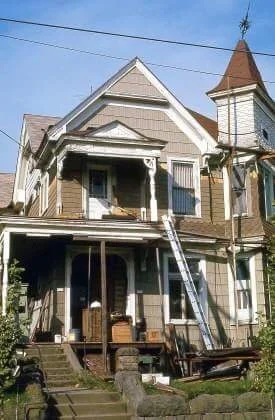BEN + JERRY
Jerry Bosco and Ben “Benny” Milligan saved and painstakingly restoring at least five of Sunnyside’s most iconic Victorian-era homes. They were active community members and many people in the neighborhood still remember and think fondly of the quirky duo.
Jerry was a high school art teacher at Benson High School. He was a soft spoken; a kind man with shaggy hair, who always had funny old clothes on. Jerry was the driving force behind the duo’s preservation efforts. Jerry’s partner Ben, was a feisty “Irish firecracker.” A skilled handyman, always willing to lend a helping hand to neighbors and help Jerry with all his projects.
In the early 1970s, when Interstate 405 was under construction, Ben & Jerry were alarmed by the tragic demolition of countless historic buildings throughout Portland. So they took action, and entered the buildings on the eve of their destruction to salvage priceless pieces of architectural heritage. If a construction crew was around, they would offer to buy things, if not, would just take them. They also went to a lot of estate sales, and took long drives in the countryside with their truck, “picking” along the way. They collected a trove of ornate building elements over the decades. This was before preservation was mainstream, so a lot of these pieces were very cheap or even given to them for free.
Many of these unique structural pieces were used in the restoration of their properties, which they also bought very cheaply back then. For example, Ben & Jerry restored the now iconic J.C. Havely (1893) & Thaddeus Fisher Houses (1881) on Belmont & SE 33rd Ave. Both of these homes were built in the late 19th century, and by the 1970s, they were in extreme disrepair when they purchased them. They would have most certainly been torn down if it were not for Ben & Jerry saving them. Ben & Jerry helped restore things all around Portland in fact. For example, with the help of their friend, artist David Delamare, Ben & Jerry restored the Roseway Theater’s Art Deco windows.
Carolyn Newson, the co-owner of Buttertoes Restaurant that was in the Havely House for a decade (1979-1989), met Ben around 1964 or 1965 when she ran a little antique shop on SE 3rd Ave. She would see Ben walking by with a bunch of art pieces; he had a restoration workshop nearby. When Carolyn and her and his two sisters were looking for a location for their new restaurant venture, Jerry offered them the bottom floor of the Havely House on Belmont. Ben & Jerry had been running a restoration business called “Victorian Facades” out of the house, but at this point it was just being used as one of their many “storage” places - packed from ceiling to floor with structural antiques and wood.
J.C. Havely House under restoration by Ben & Jerry in the 1970s.
Before Buttertoes could open, they had to redo all the sheetrock walls, which were in terrible shape, Carolyn recalls. Dedicated to saving Portland's built history, Ben & Jerry worked tirelessly to restore the homes they owned. Restoring the original siding, repairing and replacing the shingle work, windows, doors, Povey stained glass, ceiling medallions, woodwork, and even faux marble painting. Jerry was a master at plaster work, and got really good at casting and fabricating ceiling medallions, many of which are still in the Havely & Fisher Houses. Ben & Jerry also choose to paint their houses using period subtle colors, rather than following the 1970s “Colorist Movement” out of San Francisco where homeowners were painting Victorian-era homes using bold bright colors. Even with these more subdued palettes, Sunnyside’s painted ladies sure stood out after Ben & Jerry fixed them up.
Ben & Jerry lived in the Fisher House for many years. The house was so packed full of architectural pieces you had to navigate your way through using little pathways. They spent all of the little money they had on amassing their life’s collection. Carolyn recalls that she once bought them new pillows, since the ones they were using were so old and dingy. They lived and breathed restoration.
Ben & Jerry carrying a salvaged piece of the old St Mary's Academy.
They would host an annual dinner party at the Fisher House, which provided them a reason to clean up and temporarily move some of the clutter. Ben was an excellent cook. Ben and Jerry used this annual gathering to shock everyone with one of their most prized and odd possessions – a real Mummy’s hand! Carolyn recalls that after dinner, they would take down the glass case from the dining room wall and carefully unwrap the hand for the crowd. It reeked of spices and chemicals, and always got a lively reaction from their guests.
Ben & Jerry sadly passed away in the late 1980's, both falling victim to the AIDS virus. Jerry passed away first. Carolyn recalls he was always a bit frailer, due to having diabetes. He passed away at Good Samaritan Hospital in Portland, with a lot of his friends by his side. After Jerry’s passing, Ben softened up and took on a lot of Jerry’s characteristics, but he didn’t hold on much longer either, passing away just about a year later. Friends and companions, Benny and Jerry spent their lives preserving Oregon's built history. In an Oregonian interview with Ben just before his passing in 1988, he explained, "We're not collectors so much as caretakers. You start out as collectors and then later on you are caretakers. It is not a matter of saving for the future, you are saving that period of time."
Thaddeus Fisher House under restoration by Ben & Jerry in 1975.
Luckily, just before their passing, Ben & Jerry founded the Bosco-Milligan Foundation now at the Architectural Heritage Center (AHC) in Portland. They wanted to safe-guard their massive collection, and pass it on to future generations. The National Park Service documents that the Bosco-Milligan Foundation’s collections are the largest in the West and among the five largest in the United States.
These local preservation legends are featured prominently in the mural, transporting historic artifacts and treasures they saved from the wrecking ball. The Sunnyside neighborhood would certainly not be what it is today without the help from this dedicated duo, true caretakers of our history.
An Interview with Ben Milligan
SAVING PAST FOR THE FUTURE | VICTORIAN PORTLAND'S `CARETAKERS' WILL LEAVE TREASURE TO RESTORATIONS Published in The Oregonian (Portland, OR) - January 28, 1988 Author: DAN HORTSCH
For Benny Milligan, even casual conversations take an ironic turn. Such as when the gas company man comes to check out the furnace. Some house, the gas man says, after telling Milligan that he'll need to call a repairman. It is some house. The kind of house Benny Milligan knows best, a Victorian home. And Benny Milligan has spent the past 20 years caring about such houses. Going to restore it? The gas man wants to know. Working on it, Milligan says. That could take years, the gas man says. Fifteen, anyway, Milligan says. Together they enjoy the richness of this old house, and when the gas man leaves Benny Milligan sits in a house with a furnace that has gone bad in the coldest weather of the winter. He wonders whether to fix it himself or to hire out the job. A moment later Milligan talks about reality, and about the dilemma of facing it. "That was a lie,'' he says to another visitor. But, of course, he says, there was no reason to explain. No reason to explain to the gas man that Benny Milligan does not have 15 years.
Benny Milligan lives his life in another age, an age he and his friend and companion, Jerry Bosco, spent their lives preserving. This house, this Italianate wonder built in 1880 on one site and moved in 1885 to its present location on Northwest Hoyt Street, is just a small piece of their work. Bosco died in October at age 49, yet another victim of AIDS. Milligan, 50, has had the same disease for nearly two years. Now he is closing out his life in this partially restored house, remembering the good times he and Bosco had working and living together, preserving history and enjoying life. "Jerry and I had a full life,'' Milligan said, sitting in his cluttered kitchen, his legs warmed by a space heater. "We really got to play with life.''
Milligan moved to Portland from Richland, Wash., in 1964. Old buildings were rare in that area, but, Milligan realizes now, even then he had an interest in the old. "What makes a person interested in one thing?'' Milligan asked. "There's no rhyme or reason to it.'' When he moved to Portland -- a relocation spurred by a frightening fall on the job as an ironworker -- Milligan met Bosco, and their interests meshed. As a teenager, Bosco had scoured homes about to fall prey to wreckers making room for the Lloyd Center in Northeast Portland. Later, as an art teacher at Franklin High School for a dozen years, he had continued his interest in the old.
Together, Milligan and Bosco set out to save the past and, when necessary, recreate it. They bought houses in Southeast Portland and filled them with the trappings of other houses, houses that were built before 1900. And they learned how to make the parts that people needed for restoration of houses and other buildings. First they made brass hardware, and then ornamental plaster. And then they made glass, colored glass for leaded windows. "We figured anything the Victorians could do, we could reproduce,'' Milligan said. Apparently. Milligan got so good at turning out colored glass for leaded glass artifacts that one man was buying it to use in forged Tiffany windows -- something Milligan learned about when the FBI stepped in. But collecting -- saving what was there -- was their first passion, and they amassed warehouses full of the stuff. And for a reason. "Jerry and I spent most our our life educating people. A collector likes to share. If you collect and hoard everything at home, it's not as much fun.''
A foundation formed by Milligan and Bosco will continue that sharing by making their life's work available to others.
"We're not collectors so much as caretakers,'' Milligan said. "You start out as collectors and then later on you are caretakers.'' It is not a matter of saving for the future, Milligan said, looking about his old house. "You are saving that period of time.''
Copyright (c) 1988 Oregonian Publishing Co.








